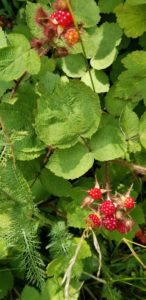My late father-in-law used to say “A weed is any plant in a place where you don’t want it.” Yes, I have a wineberry weed in a stone wall in the middle of a flower garden. Later this year I will have to take apart a section of stone wall and try to dig out the roots of this weed.
However, I like wineberries (rubus phoenicolasius) , just not in the middle of a flower garden. Found along roadsides, locals know that picking these wild, bright orange-red, jewel-like berries, sometimes called wild raspberries, provides a delicious snack, even though they are a bit sticky and have lots of seeds. Those berries develop inside a fuzzy calyx until they are ripe. Then the calyx opens and there each jewel shines until harvested. They have a little tang of tartness to balance their sweetness. These non-native raspberries were brought from Asia in the 1800s for cross breeding with domestic raspberries, but they escaped from the breeders. They have made themselves at home here in Pennsylvania and elsewhere east of the Mississippi River.
This was a very good year for wild berries. I picked more than two quarts of wineberries this month, just along the road where I live, and made some jam. The berries are delicious to eat raw, providing lots of vitamin C and antioxidants. Of course, one can also use wineberries in pies or any other recipes for berry desserts. There is competition for these berries. Birds love them too. I have seen turkeys jumping up to get the berry just out of reach. Song birds are delighted to pick those berries. Raccoons, deer and even turtles have been known to eat wineberries, so it’s wise to leave some on the canes for them.


